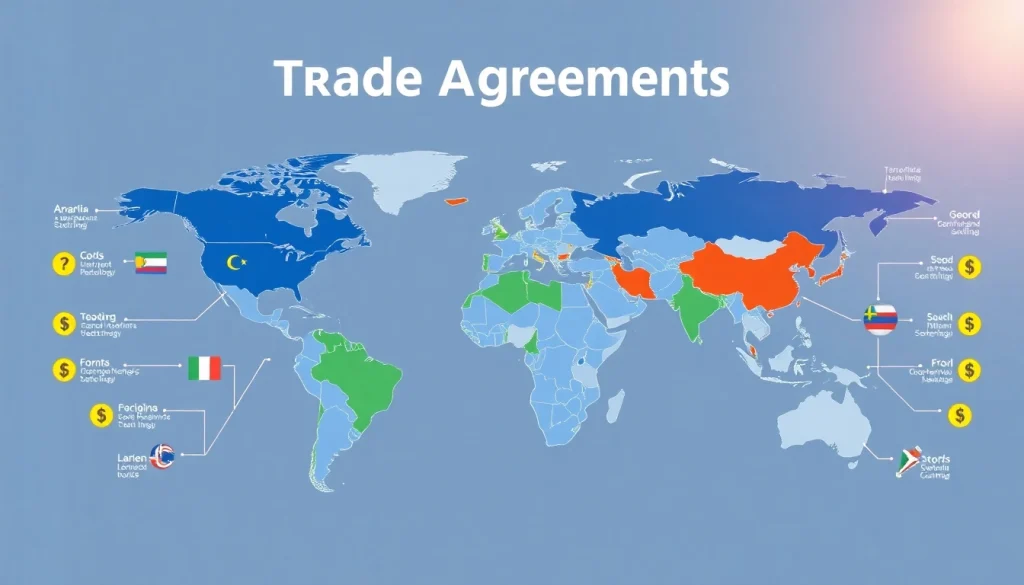
What Are Trade Agreements?
Definition and Purpose of Trade Agreements
Trade agreements are treaties or contracts between countries that establish the rules for trade among them. They can cover a wide range of areas, including tariffs, import quotas, and trade barriers, with the overarching goal of promoting free trade and economic cooperation. The primary purpose of these agreements is to enhance the flow of goods and services across borders, ultimately benefiting all parties involved by increasing market access and fostering competition.
Through trade agreements, countries aim to reduce or eliminate tariffs and other trade barriers, which can lead to lower prices for consumers, increased exports for producers, and stronger economic growth. Additionally, they often include provisions regulating investment, labor, environmental standards, and intellectual property rights, thereby creating a more predictable environment for businesses operating internationally.
Types of Trade Agreements
Trade agreements can be categorized into several types based on their scope and complexity:
- Bilateral Agreements: These involve two countries and are designed to facilitate trade between them. An example is the U.S.-Australia Free Trade Agreement.
- Multilateral Agreements: These involve three or more countries and typically encompass broader trade and economic integration. Examples include the North American Free Trade Agreement (NAFTA) and the Comprehensive and Progressive Agreement for Trans-Pacific Partnership (CPTPP).
- Regional Trade Agreements: These agreements involve countries within a specific geographic region collaborating to enhance trade relations. The European Union (EU) serves as an exemplary model of a regional trade agreement.
- Customs Unions: These are agreements where member countries agree to a unified external tariff on imports from non-member countries. The Economic Community of West African States (ECOWAS) is one such example.
Historical Context and Evolution
The concept of trade agreements dates back centuries, but their significance intensified in the 20th century with the establishment of the General Agreement on Tariffs and Trade (GATT) post-World War II. This agreement aimed to reduce tariffs and foster international trade; it laid the foundation for what would later become the World Trade Organization (WTO) in 1995.
In recent years, the landscape of trade agreements has evolved, with a shift towards more comprehensive agreements that address not just tariffs but also regulatory standards, labor rights, and environmental protections. As globalization continues to advance, countries are increasingly recognizing the importance of forging strong trade relationships to stay competitive in the global market.
Major Trade Agreements Worldwide
North American Free Trade Agreement (NAFTA)
Established in 1994, the North American Free Trade Agreement (NAFTA) facilitated trade between the United States, Canada, and Mexico by eliminating tariffs on most goods traded among the three countries. NAFTA was significantly impactful as it created one of the world’s largest free trade zones and has been credited with boosting trade and investment among the member countries. However, it also faced criticism for job losses in certain sectors, particularly manufacturing.
In response to the criticisms and changing economic conditions, NAFTA was replaced in 2020 by the United States-Mexico-Canada Agreement (USMCA), which modernized trade relations by updating provisions on labor rights, environmental standards, and digital trade.
European Union Trade Agreements
The European Union (EU) represents one of the most comprehensive trade agreements globally, enabling the free movement of goods, services, people, and capital among its member states. In addition to internal agreements, the EU has negotiated trade deals with various countries and regions outside of its borders. These agreements often include provisions addressing regulatory cooperation, market access, and sustainable development.
Some of the significant trade agreements involving the EU include the EU-Canada Comprehensive Economic and Trade Agreement (CETA) and the EU-Japan Economic Partnership Agreement. Through these agreements, the EU aims to strengthen its global trade position while promoting standards that support environmental sustainability and social rights.
Recent US Trade Agreements with Asia
The U.S. has increasingly focused its trade policy on the Asia-Pacific region, seeking to enhance economic ties with key partners. The TPP was one such initiative aimed at establishing a comprehensive trade framework within the Asia-Pacific. Following the U.S. withdrawal from TPP, efforts have shifted towards bilateral agreements, most notably with countries like Japan and South Korea. For example, the U.S.-Korea Free Trade Agreement (KORUS) has been crucial in expanding trade between the two nations and includes provisions on trade in goods and services, investment, and intellectual property.
Moreover, the Biden administration has expressed interest in revitalizing partnerships in the region to counterbalance China’s economic influence and promote fair trade practices.
The Role of Trade Agreements in Economic Growth
Boosting Exports and Imports
Trade agreements are instrumental in boosting exports and imports by removing trade barriers and creating more favorable conditions for trading partners. By lowering tariffs and eliminating quotas, trade agreements allow companies to expand their market reach. For instance, after the implementation of NAFTA, trade between the U.S., Canada, and Mexico increased significantly, with exports to Canada and Mexico growing by over 300% in the agreement’s first two decades.
Furthermore, trade agreements encourage countries to diversify their export markets, reducing dependency on single markets and enhancing global market resilience, which is particularly vital in times of economic uncertainty.
Impact on Local Economies
At the local level, trade agreements can lead to increased economic growth, job creation, and community development. For example, cities and regions that are integral parts of trade networks often experience job creation in logistics, transportation, and export-oriented industries. For instance, research has shown that regions near ports and major trade routes can see substantial economic benefits due to increased shipping and manufacturing activities.
However, while many sectors flourish due to trade agreements, others may suffer due to increased competition from imports. Policymakers must therefore implement strategies to support affected industries and workers through transition programs, such as retraining and vocational education.
Long-term Economic Relationships
Trade agreements foster long-term economic relationships between countries, promoting trust and cooperation in various facets beyond trade. These relationships can lead to collaborative efforts in areas such as technology transfer, innovation, and sustainability initiatives. A prime example can be seen in the EU’s trade agreements, which often include components emphasizing sustainable practices, social standards, and environmental protections.
Additionally, trade agreements can pave the way for political stability and peace. Historically, countries deepening their economic ties often experience reduced tensions and increased collaboration on global issues. By establishing robust trade agreements, nations work towards building platforms for dialogue and cooperation on broader geopolitical matters.
Challenges in Trade Agreements
Political and Economic Disputes
One of the primary challenges in establishing and maintaining trade agreements is the political and economic disputes that can arise between countries. Disagreements over trade practices, tariffs, and regulatory standards can lead to trade wars or the suspension of agreements altogether. The recent trade tensions between the U.S. and China are a telling example of how disputes can escalate and affect global markets.
To mitigate these challenges, it is crucial for countries to engage in continuous dialogue and negotiations, maintaining flexibility and open communication channels. Many trade agreements include mechanisms for dispute resolution to help address conflicts before they escalate into more significant issues.
Compliance and Enforcement Issues
Ensuring compliance with trade agreements can be challenging, especially when countries have differing regulatory standards, enforcement mechanisms, and levels of development. For instance, disparities in intellectual property rights enforcement can lead to significant challenges in maintaining fair trade practices.
To address these issues, comprehensive monitoring and reporting systems need to be established, enabling countries to track compliance and enforce the terms of the agreements effectively. Regular reviews and updates of the agreement provisions may also be necessary to adapt to changing economic realities.
Public Sentiment and Trade Policies
Public sentiment often plays a critical role in shaping trade policies and agreements. Concerns over job losses, environmental degradation, and inequality can lead to public backlash against certain trade agreements. Political leaders must therefore remain responsive to their constituents’ concerns and prioritize transparency and inclusion in negotiations.
Furthermore, integrating local stakeholders and experts into the negotiation process can help ensure that trade agreements reflect broader societal interests and gain public support.
The Future of Trade Agreements
Emerging Trends in Global Trade
The future of trade agreements is likely to be characterized by a shift towards more comprehensive and inclusive arrangements that prioritize sustainability, digital trade, and social equity. Increasingly, countries are recognizing the need to address global challenges such as climate change and labor rights within the framework of trade. This has led to the integration of sustainable development goals in trade negotiations and agreements worldwide.
Moreover, the rise of e-commerce and digital trade is driving a new wave of agreements that focus on data flow, cybersecurity, and online market accessibility. The EU’s Digital Trade Agreement is a notable example, seeking to establish standards for digital services and network resilience across its member countries and trading partners.
Technological Advancements Impacting Trade
Technological innovations are profoundly impacting the ways trade agreements are negotiated and implemented. Enhanced data analytics and digital technologies enable countries to better assess trade impacts, monitor agreements, and improve compliance tracking. Blockchain technology, for instance, holds potential for enhancing transparency and traceability in trade transactions, ensuring that standards are met and reducing fraud.
Furthermore, advances in communication technologies can facilitate real-time discussions and negotiations among countries, potentially speeding up the process of establishing new trade agreements in response to rapid global shifts.
Potential Shifts in Trade Policies Post-COVID-19
The COVID-19 pandemic has reshaped global trade dynamics, prompting countries to reassess their supply chains and trade dependencies. As nations emerge from the pandemic, there may be a renewed focus on diversifying sources of imports and exports, leading to localized production and reshoring initiatives. Consequently, trade agreements could evolve to prioritize resilience and sustainability over mere economic efficiency.
Additionally, there might be increased emphasis on healthcare and medical supplies in trade discussions, driven by lessons learned from the pandemic regarding global health security. As a result, future trade agreements may incorporate provisions that address health standards, emergency supply chains, and collaborative responses to health crises.






